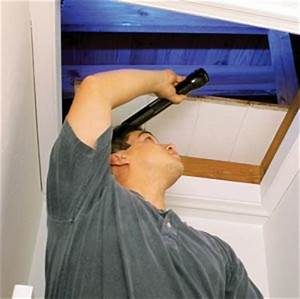Home Allergen Testing Limitations
Surprisingly rodent infestations in our homes often go unnoticed. They can hide and breed in walls, crawl spaces, basements, and attics. In Florida they are most common in attics and commonly cause indoor air quality problems without the homeowner ever knowing they are present. Home allergen inspections are a good way to determine if you have rodent problems that may be causing allergy problems in your home.
In addition the allergens they release can cause coughing, sneezing, and watery eyes. As a result it is important that the presence of rodents be discovered so they can be exterminated if found to be present. As we have discussed in other areas of our mold inspection website hiring someone for home allergen testing can be beneficial at times, and in many cases allergen inspections without the need for testing may be more reliable.
Home tests for mice or Norway Rat allergens may not pick up allergens released by Roof Rats. This is a problem if you live in Florida and have rat allergens in your home. Roof Rats are much more common in Florida and their allergens do not show up in some rodent allergen tests.
The Home Allergen Testing Alternative
So if testing for allergens can fail what is the answer? How do you know if you have a problem with rodent allergens in the home? Rodent allergens may not be sampled, but the presence of a problem can be ascertained by finding rodent signs in the attic during a detailed visual allergen inspection. Most of the time we find problems in the attics that the clients never knew existed.
Nine Things to Look For When Inspecting For Rodents:
- Rodent odors in the attic. When entering an attic infested with rodents the first thing one will notice is a rodent odor. Of course, if you are not an inspector you may not know if you are smelling rodent odors, or attic odors. Often it is difficult even for an inspector to distinguish mild rodent odors from strong attic odors.
- Rodent trails through insulation in the attic. Rodents cannot turn lights on in the dark, so they follow their own old scent trails, and the scent trails of other rodents. As the rodents follow the same exact paths over and over again in the dark they erode paths in the insulation. Roof Rat paths are about 3 inches wide and an inch or two deep and extend several foot in one direction.
- Footprints and tiny claw scratch marks on dusty AC ducts in the attic.
- During home allergen inspections we look for chewed AC refrigerant line insulation. It is so much easier for a rat to lick up condensation water from cold refrigerant lines than it is to leave the attic and find the nearest canal. But a smart rodent must first chew away the insulation that is covering that cold refreshing water.
- Rodent droppings, they look like black grains of rice.
- Rodent urine stains on insulation.
- Rarely rodents in our area (South Florida) will actually leave the attic and enter a homes occupied areas. When rodents do enter our living spaces they may chew holes in walls or in baseboards or the bottom of cabinets. Below are images of holes made by rats in a West Palm Beach home we inspected.
- When Rodents share our homes they enjoy helping themselves to our food. Holes chewed in boxes of pasta or bread bags etc. can be signs of rodents.
- Tiny red stop signs and yellow yield signs mysteriously appearing in various areas of your home. Rodent install these to control movements among their own kind. No wait, oh yea that was a cartoon, never mind that last one.
Photos of Common Rat Indicators Found During Home Allergen Inspections and Rodent Inspections
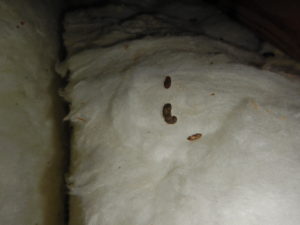
Roof rat droppings found on insulation in an attic. This was during a mold and allergen inspection in Western Palm Beach County.
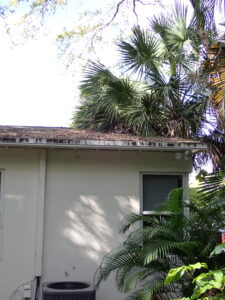
Trees provide access to roofs for rats. Once on the roof the rats can enter the attic via roof vents.
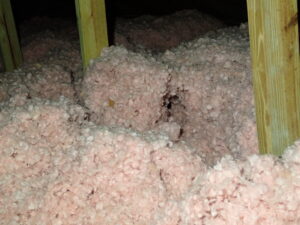
View of rat tunnel in attic insulation in a Coconut Creek home in Broward County Fl.
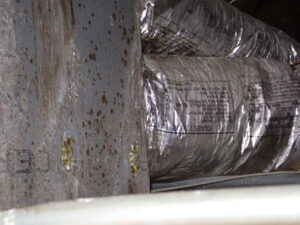
Some roof rats learn to chew holes in AC duct insulation. They do this to gain access to condensation used by them as a source of drinking water. Look closely and you may see the two small yellow holes. Coconut Creek Fl.
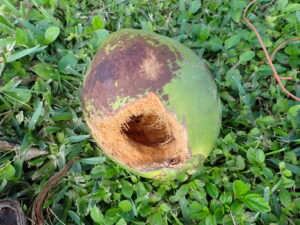
A coconut laying in the grass. It has a hole in it because rats chewed a hole in it to gain access to its inner flesh and water. I have only seen this occur in this one area of Coconut Creek in Broward County Fl. The client reported that this is a common learned practice for roof rats (Ratus Ratus) in her neighborhood.
A Case Study From One Of Our Many Rodent Allergen Inspections
Rodents can spread many diseases. I once conducted an inspection, I think it was in West Palm Beach. The occupants were complaining of odors and allergies. They had no idea of what the source was. When I went into the attic I found evidence of a severe rodent infestation. I concluded that the rodent infestation in the attic was the source of the odor and allergen problems. But their is more to the story, one of the kids residing in the home had a rare disease that is caused by rodents. It is very possible that the rodents in the attic caused the boys disease. He also had a pet hamster and that hamster may have been a possible source of the disease as far as I know.
It is less likely that the disease came from the hamster for the following reasons:
1) Like rats pet hamsters are rodents, but they are very clean animals bred in captivity for many generations.
2) Hamsters eat clean pet food for many generations and are not scavengers like the rats in the clients attic.
3) Unlike rats, hamsters never likely touch soil, other animals feces, or infected animals.
Thus it is less likely that the disease came from the family pet. I instructed the clients to get rid of the pet hamster and remediate the attic and exterminate the attics rodents.
Rats and Diseases
Rodents cause many illnesses, in fact their is a comprehensive list of rodent related diseases at this site:
Centers of Disease Control list of diseases spread by rodents:
Here is a list of those diseases here.
-Hantavirus Pulmonary Syndrome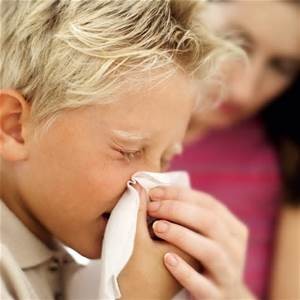
-Hemorrhagic Fever with Renal Syndrome
-Lassa Fever
- Leptospirosis
- Lymphocytic Chorio-meningitis (LCM)
- Omsk Hemorrhagic Fever
- Plague
- Rat-Bite Fever
- Salmonellosis
- South American Arenaviruses (Argentine hemorrhagic fever, Bolivian hemorrhagic fever, Sabiá-associated hemorrhagic fever, Venezuelan hemorrhagic fever)
- Tularemia
Looking for information on other home allergens try here.

